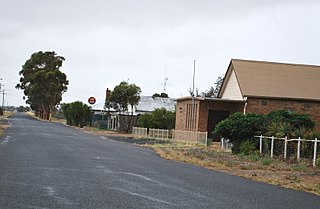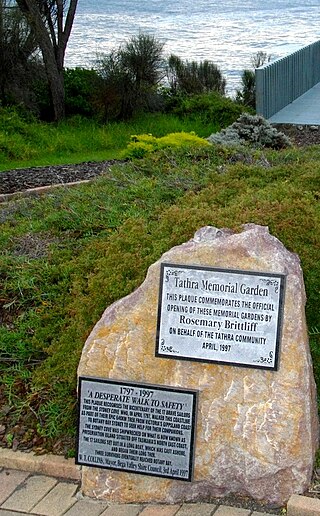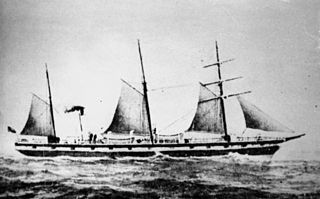
Bass Strait is a strait separating the island state of Tasmania from the Australian mainland. The strait provides the most direct waterway between the Great Australian Bight and the Tasman Sea, and is also the only maritime route into the economically prominent Port Phillip Bay.
King Island is an island in Bass Strait, belonging to the Australian state of Tasmania. It is the largest of four islands known as the New Year Group and the second-largest island in Bass Strait. The island's population at the 2021 census was 1,617 people, up from 1,585 in 2016. The local government area of the island is the King Island Council.

Cataraqui was a British barque which sank off the south-west coast of King Island in Bass Strait on 4 August 1845. The sinking was Australia's worst–ever maritime civil disaster incident, claiming the lives of 400 people.

The Bass Strait Triangle is the waters that separate the states of Victoria and Tasmania, including Bass Strait, in south-eastern Australia. The term Bass Strait Triangle appears to have been first used following the disappearance of Frederick Valentich in 1978 although the region had a bad reputation long before that.

Netherby is a town in western Victoria, in Australia. The town is approximately 406 kilometres (252 mi) north west from Melbourne.
Sir Charles Hardy Islands is in the reef of the same name adjacent to Pollard Channel & Blackwood Channel about 40 km east of Cape Grenville off Cape York Peninsula.

Booby Island is located 45 km (28 mi) northwest of Muttee Heads at the tip of Cape York Peninsula in Queensland, Australia. This island is in the Torres Strait, 32 km (20 mi) west of Thursday Island and 23 km (14 mi) west of Prince of Wales Island. Booby Island is also known as Ngiangu by the Kaurareg people of the western Torres Strait, its traditional owners, named for the giant Ngiangu who was forced from a neighbouring island It has been called Booby Island by a number of European explorers, including Captain Cook, for the presence of the booby birds.

Sydney Cove was the Bengal country ship Begum Shaw that new owners purchased in 1796 to carry goods to Sydney Cove, and renamed for her destination. She was wrecked in 1797 on Preservation Island off Tasmania while on her way from Calcutta to Port Jackson. She was among the first ships wrecked on the east coast of Australia.
Neva was a three-masted barque launched in 1813. She made two voyages transporting convicts to Australia. On her second voyage carrying convicts she wrecked in Bass Strait on 13 May 1835. Her loss was one of the worst shipwrecks in Australian history; 224 people died.
Cape Otway is a cape and a bounded locality of the Colac Otway Shire in southern Victoria, Australia on the Great Ocean Road; much of the area is enclosed in the Great Otway National Park. The cape marks the boundary between the Southern Ocean on the west and Bass Strait on the east.

Wingan Inlet is an inlet within the Croajingolong National Park, in the East Gippsland region of Victoria, Australia.

Currie is a rural residential locality in the local government area (LGA) of King Island in the North-west and west LGA region of Tasmania. The 2021 census recorded a population of 659. It is the largest township on, and is the administrative centre of, King Island, at the western entrance to Bass Strait.
The following lists events that happened during 1866 in Australia.

SS City of Launceston was a 368 GRT steamship operated by the Launceston and Melbourne Steam Navigation Company from 1863, which had an early role in colonial steam shipping as the forerunner of the modern Bass Strait ferry service between Tasmania and Victoria. It was sunk in Port Phillip Bay after a collision with another ship on 19 November 1865.

SS Gothenburg was an iron-hulled sail- and steamship that was built in England in 1854 and sailed between England and Sweden until 1862. She then moved to Australia, where she operated across the Tasman Sea to and from New Zealand until 1873, when she was rebuilt. After her rebuild, she operated in the Australian coastal trade.

HMVS Victoria was a 580-ton combined steam/sail sloop-of-war built in England in the 1850s for the colony of Victoria, Australia.

William Henry Norman (1812–1869) was a sea captain in Australia. As commander of HMVS Victoria, he engaged in the First Taranaki War in New Zealand and the search for explorers Burke and Wills.

The vessel MV Blythe Star was a coastal freighter which foundered off south-western Tasmania in October 1973. The crew of 10 successfully took to a small inflatable liferaft but drifted undiscovered. A search for the ship and its crew led to the largest maritime search operation conducted in Australia to that time.

Charles Eaton was a barque, launched in 1833 for use as a merchant ship. Whilst under the command of Captain Fowle, she was wrecked in 1834 among the Torres Strait Islands, off the northern coast of Queensland, Australia, and her passengers and crew attacked and nearly all killed by Torres Strait Islanders on Mer Island. A cabin boy and small child survived and lived with the islanders until being rescued by Captain Lewis and crew on Isabella in June 1836, who also found skulls of some of the murdered people on a nearby island and took them back to Sydney for burial.













